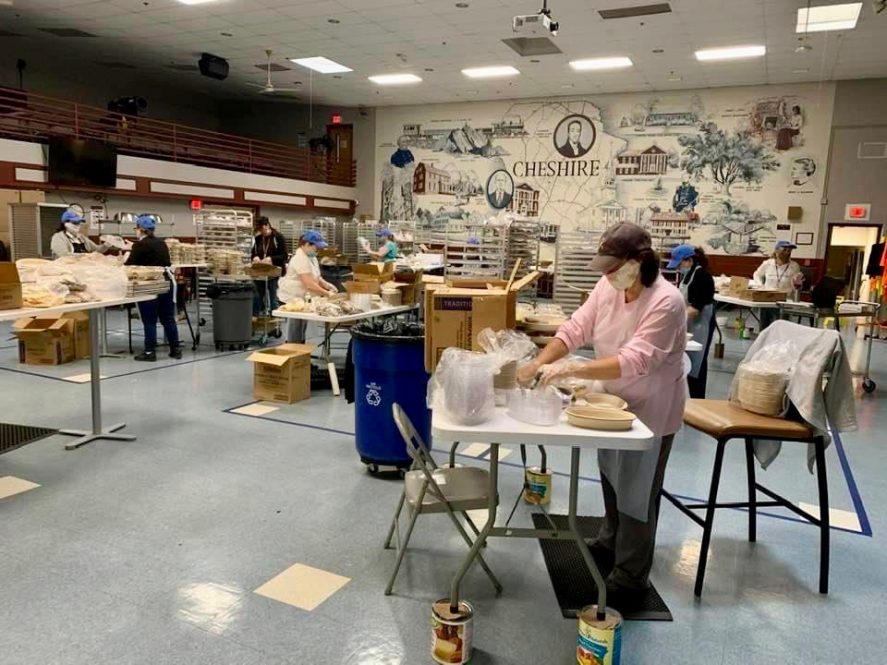In mid-March 2020, school buildings closed and the total number of school meals served in Connecticut dropped by 32% in the first two weeks. But, thanks to the creative outreach and flexibility exhibited by school food service directors, these numbers rebounded, according to a new study from researchers at the UConn Rudd Center for Food Policy and Obesity.
Prior to the pandemic, one in seven American households with children experienced food insecurity, defined as limited access to adequate food due to a lack of money or other resources. From the onset of COVID-19 and the resulting school closures in March 2020, millions of students from food-insecure families who rely on the school meal program were at risk of missing those meals.
“Last spring, we heard how food service staff all over the country had quickly pivoted from preparing and serving meals in cafeterias to packing up and distributing school meals throughout their communities,” says Marlene Schwartz, Director of the UConn Rudd Center and senior author of the study. “We wanted to learn how our local districts in Connecticut had managed, so we worked with our State Department of Education to understand how many meals were served and how they did it.”
After a marked decrease in March, the number of meals served in April and May was comparable to the number of free and reduced-price meals served during the same months in 2019. In total, districts provided over 11 million meals to students between mid-March and June, reaching a high of 3.8 million meals in the month of May alone.
“We are grateful to all of Connecticut’s school food and nutrition directors and staff who, virtually overnight, went to heroic measures to innovate and shift from cafeteria meal service to providing “grab and go” meals in a way that has never been required or done before. These school nutrition heroes put their own health at risk to provide a critical lifeline and stability for children and households grappling with food insecurity by ensuring they continued to have access to healthy meals,” says Education Commissioner Miguel Cardona ’01 MA, ’04 6th Year, ’11 Ed.D., ’12 ELP, who has been nominated to serve as U.S. Secretary of Education. “I must also acknowledge our team at the State Department of Education who worked around the clock to submit waiver requests to the USDA, implement the flexibilities approved by the federal government, and authorize our school programs to begin emergency meal service for our students without gaps in receiving school meals.”
To estimate the percentage of students at risk of food-insecurity who were reached after buildings closed, researchers compared the number of lunches distributed to the number of students eligible for free and reduced-price meals in 120 Connecticut districts. The research team also conducted comprehensive interviews with a sample of school food service leaders to discover the strategies they used to overcome the challenge of keeping children fed during a pandemic.
Key findings include:
- After the initial steep drop in March, the number of lunches distributed in April and May was 70% of the total number of students eligible for free and reduced-price lunches. This reach is comparable to the number of free and reduced-price meals served a year earlier during April and May 2019.
- Most districts set up “grab-and-go” meal distribution sites. This required new production operations, to-go containers, and equipment. The distribution sites were located and set up with hours of operation to ensure maximum access by families.
- To increase participation, food service directors used every communication channel available, including email, social media, phone calls, and outdoor banners. They also worked with community partners such as food pantries, libraries, community groups, and city hall.
- Despite federal waivers that allowed flexibilities in school nutrition program regulations, the food service directors interviewed said that the meals served reached the same level of nutritional quality because they were using the same ingredients as before.
- Food service directors reported an increase in staff morale, innovation, flexibility, and confidence after the experience of serving meals in the spring of 2020.
Study authors say findings from this research not only raise awareness of how drastically COVID-19 impacted school meal distribution, but also provide valuable insight into how school districts can respond to potential shutdowns and long-term school closures in the future.
Funding for this study was provided by the Connecticut State Department Education through a grant from the U.S. Department of Agriculture’s Food and Nutrition Service, and the Middlebury College Center for Careers and Internships.



